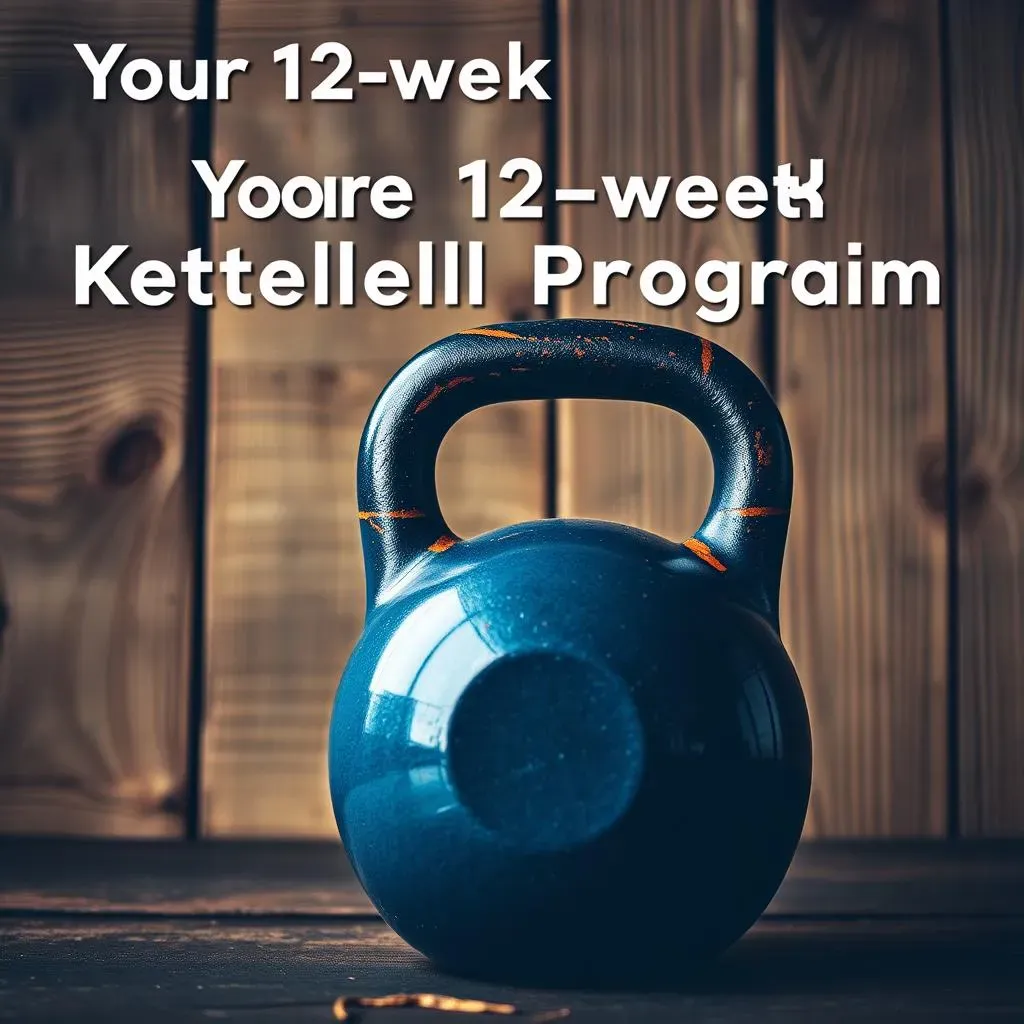Table of Contents
Ever feel like your workouts are stuck in a rut? Maybe you're looking for something that packs a punch, builds real-world strength, and doesn't require a ton of fancy equipment. That's where kettlebells come in. And if you're thinking about starting, but not sure where to begin, you're in the right place. We’re going to walk through a complete beginners kettlebell program- 12 weeks plan that's designed to get you moving, feeling stronger, and more confident. This isn't about endless hours in the gym. It's about smart, effective training that fits into your life. We'll break down why this program is awesome for beginners, lay out the exact workout plan week by week, and give you the tips you need to make it work. Think of this as your guide to a stronger, fitter you, using just one awesome piece of equipment. So, grab your kettlebell and let's get started.
Why Choose a 12Week Kettlebell Program?

Why Choose a 12Week Kettlebell Program?
Time to Ditch the Workout Rut
Let's be real, are you tired of the same old gym routines? The treadmill monotony and the endless bicep curls? I know I was. That's where kettlebells swooped in like a superhero. They're not just some trendy fitness fad; they are a powerhouse for building functional strength. A 12-week program isn't some random number either, it is a sweet spot. It gives your body enough time to adapt and make real progress, without burning out. It's like planting a seed and watching it grow – but instead of a plant, it's your muscles getting stronger.
Plus, a structured program takes out all the guesswork. You don't need to wander around the gym wondering what to do next. This plan is like a roadmap, leading you step-by-step towards your goals. You'll know exactly what exercises to do, how many reps, and when to rest. This saves you time and mental energy, so you can focus on crushing your workout. Trust me, that feeling of accomplishment at the end of a well-planned session is totally worth it.
More Than Just Muscles
Okay, so we know kettlebells build strength, but it’s more than that. This 12-week program isn't just about getting bigger biceps. It is about developing all-around fitness. Think improved endurance, better balance, and increased flexibility. These are things that actually matter in your day-to-day life. Imagine being able to carry groceries without feeling winded, or bending down to pick something up without your back protesting. That's the kind of functional fitness we're talking about.
And let’s not forget the mental benefits. There's something incredibly empowering about mastering a new skill, like a kettlebell swing. It boosts your confidence and makes you feel like a total badass. Plus, the focused effort required during a workout is a fantastic stress reliever. It is like a mini-meditation session but with weights. So, if you’re looking for a workout that challenges both your body and mind, a 12-week kettlebell program is where it is at.
Benefit | Description |
|---|---|
Structured Plan | Removes guesswork, provides clear direction. |
Functional Strength | Builds real-world strength applicable to daily activities. |
Full-Body Workout | Engages multiple muscle groups, improving overall fitness. |
Mental Benefits | Boosts confidence, reduces stress. |
Your 12Week Beginners Kettlebell Program: A Detailed Plan

Your 12Week Beginners Kettlebell Program: A Detailed Plan
Phase 1: Building Your Foundation (Weeks 1-4)
Alright, let's get into the nitty-gritty. This first phase is all about getting comfortable with the basic kettlebell moves. Think of it as learning the alphabet before writing a novel. We’re not trying to break any records here; we're focusing on form and building a solid base. You'll be doing things like kettlebell deadlifts, goblet squats, and swings. These exercises engage multiple muscle groups and get you moving in a way that's both challenging and functional. The key is to go slow, control the weight, and really feel the movement. Don't rush it; this is where you build the foundation for the weeks ahead.
During these first four weeks, aim for three workouts per week, with a rest day in between. This will give your muscles time to recover and adapt. The goal is to get your body used to the movements and build some basic strength. You should be able to complete the workouts without feeling totally wiped out. If you do feel exhausted, take an extra rest day. Listen to your body. It’s smarter than you think. And remember, consistency is more important than intensity at this stage. It is like learning to ride a bike; you might wobble a bit at first, but with practice, you'll get the hang of it.
Phase 2: Increasing the Intensity (Weeks 5-8)
Now that you've got a handle on the basics, it's time to crank things up a notch. In this phase, we'll start to increase the weight, reps, or sets, depending on how you're feeling. You’ll be adding in exercises like the kettlebell press, rows, and lunges. These movements are going to challenge your strength and endurance, pushing you to the next level. It is like moving from riding on training wheels to riding on two wheels; it might feel a little scary at first, but it’s also super exciting.
You will still be aiming for three workouts a week, but you'll find that each session will be more challenging. Make sure that you are still focusing on good form. It is better to do fewer reps with good technique than more reps with bad form. You might also find that you need an extra rest day between workouts. Don't be afraid to take it. Recovery is just as important as the workout itself. Remember, this is a marathon, not a sprint. You're building strength and endurance that will last you for the long run.
Phase | Focus | Exercises | Intensity |
|---|---|---|---|
Phase 1 (Weeks 1-4) | Building Foundation | Deadlifts, Goblet Squats, Swings | Low |
Phase 2 (Weeks 5-8) | Increasing Intensity | Press, Rows, Lunges | Moderate |
Phase 3: Putting it All Together (Weeks 9-12)
We're in the home stretch now. In this final phase, it's all about putting everything you've learned together. You will be combining exercises, doing circuits, and adding some more advanced movements. This might include things like snatches, cleans, and Turkish get-ups. These movements are complex, so make sure you’ve mastered the basics before attempting them. Think of this as putting all the pieces of the puzzle together; each exercise builds on the others, creating a complete fitness picture.
Your workouts will be challenging, but you should also be feeling stronger and more confident than ever. You might even surprise yourself with how much you’ve progressed. Keep pushing yourself, but listen to your body and take rest days when you need them. By the end of this phase, you'll have completed a full 12-week kettlebell program. You will have gained a ton of strength, endurance, and confidence. It is like finishing a big project and feeling that sense of accomplishment that’s hard to beat. You did it. Now it’s time to celebrate your progress.
Getting the Most Out of Your 12Week Kettlebell Journey

Getting the Most Out of Your 12Week Kettlebell Journey
Consistency is Your Secret Weapon
Okay, so you've got the plan, you've got the kettlebell, and you're ready to go. But here's the thing: the best workout program in the world won't do a thing if you're not consistent. It's like trying to learn a new language by only studying once a month; you're not going to get very far. Aim for those three workouts a week, and try to stick to a regular schedule. This doesn't mean you have to be a robot about it. Life happens, and sometimes you'll miss a workout. But the key is to get back on track as soon as possible. It's like a train; if it gets derailed, it can get back on the track, but if it derails and never gets back on the track it will be a big problem.
Consistency is also about being present during your workouts. Put away the phone, focus on your form, and really feel the movement. Don't just go through the motions. Each rep should be intentional and controlled. This will not only make your workouts more effective, but it will also help you stay engaged and motivated. Remember, this is your time, so make the most of it. It's not about perfection; it's about showing up and putting in the effort, day after day.
Fuel Your Body Right
You wouldn't put bad fuel in a race car, would you? So why would you put bad fuel in your body? Your nutrition is a crucial part of this 12-week journey. You need to eat enough of the right foods to support your workouts and help your muscles recover. Focus on whole, unprocessed foods like fruits, vegetables, lean proteins, and complex carbohydrates. These will give you the energy you need to crush your workouts and help your body repair itself after each session. It's like building a house; you need the right materials to make it strong and sturdy.
Also, don't forget to stay hydrated. Water is essential for all bodily functions, including muscle recovery. Aim to drink plenty of water throughout the day, especially before, during, and after your workouts. And if you're feeling hungry, don't ignore it. Fuel your body with healthy snacks like nuts, seeds, or a piece of fruit. This isn't about dieting, it's about nourishing your body so that it can perform at its best. Think of your body as a finely tuned machine; it needs the right fuel to run smoothly.
Listen to Your Body
This one is important. It is very important. I can't stress this enough: listen to your body. If you're feeling pain, stop. Don't push through it. Pain is your body's way of telling you something is wrong. It's better to take a rest day or modify an exercise than to risk an injury that could set you back weeks. It is like a car's warning light; if it comes on, you should probably pull over and check it out.
Also, pay attention to how you're feeling mentally. If you're feeling stressed or burnt out, take a break. A workout should make you feel better, not worse. It is okay to take a few days off if you need to. The key is to come back feeling refreshed and ready to go. This 12-week program is a journey, not a race. Be patient with yourself, celebrate your progress, and enjoy the process. And remember, you're stronger than you think.
Tip | Description |
|---|---|
Consistency | Stick to a regular workout schedule. |
Nutrition | Fuel your body with whole, unprocessed foods. |
Listen to Your Body | Rest when needed and don't push through pain. |